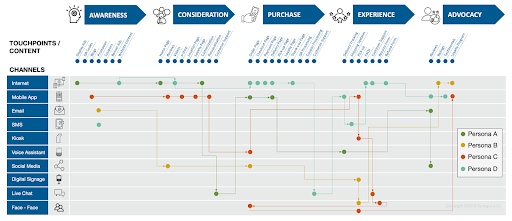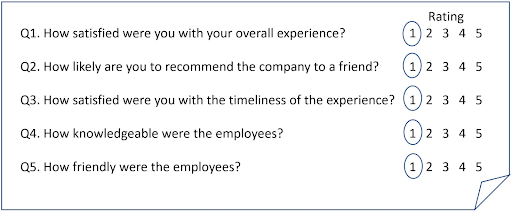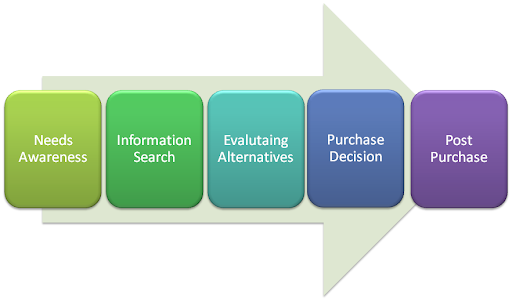These days, the quality of your product or service isn’t enough to compete effectively as a consultant.
The best way to get ahead is to focus on client service and make it a core part of your overall marketing strategy.
But, in order to incorporate the needs of your clients properly, you have to get to know them well and find out more about their experiences whenever they interact with your business. In other words, you have to map out a customer journey and optimize each stage.
The best way to do so is by using assessments to find out what clients really want (and not what you think they want).
Read on to learn how to integrate assessments in a customer journey map so you can survey clients directly and learn how they really feel.
What is a customer journey map?
The customer journey is the total sum of experiences clients go through when they interact with your brand at different touchpoints.
A customer journey map simply refers to the visual representation of the process the client or prospect undergoes in an effort to achieve a specific goal(s) with a company or brand.
The goal could be buying a product, signing up for an email newsletter, joining a rewards program, and so on.
Customer journey mapping includes the following:
- The Buying Process
- User Actions
- User Emotions
- Pain Points
- Solutions
Here’s an example of a customer journey map showing the client’s path from brand awareness, all the way to brand advocacy:

With a better understanding of the customer journey, you’ll be able to plot a customer journey map that will help you gain better insights into exactly what will motivate your target clients and encourage them to achieve these business goals and it’s likely that this information will also help you in writing winning business proposals.
Here’s an example of a customer journey with “pings” at each touchpoint:
- A potential client is browsing online and looking for someone to be a marketing consultant for their company. (ping)
- She clicks it and is taken to your landing page (ping)
- She is welcomed onto the page with a free discovery call to help determine if the consulting arrangement is a good fit (ping)
- She inputs her email to get access to scheduling software to set the discovery call (ping)
- She then proceeds to set up the call on the software (ping)
Alternatively, that same client might change her mind about scheduling the call and click away.
But now, you have her email address for future promotions and a few weeks later you send a promotional email automatically with your email marketing service (ping)… and so on, and so forth.
The scenarios are endless, but the important thing to consider is that if you are not paying enough attention or doing your best to understand the mindset of your clients, it can be all too easy to sell your brand short.
When clients experience frustration at any one of the many touchpoints, that experience is added to the full sum that they will associate with your company and brand.
This means that with enough negative experiences, that client might consider your competitor over you when they want to purchase the product again.
Even worse, they might use word-of-mouth or online review sites to say negative things about your company and brand!
That’s why it’s crucial to pay attention to the way clients experience your brand each step of the way.
Why integrate assessments into customer journey maps?
Customer journeys used to be simple. But, these days consumers interact with companies in a variety of ways, many of which can be tricky to pin down.
The customer journey can involve everything from the moment the client gains awareness of a brand through a channel like social media, TV, magazines, etc., right up until they receive a “Thank you” email after making a purchase.
It can go even beyond that to encompass client loyalty and brand advocacy.
Different businesses have different customer journeys with varied steps in between. As such, this isn’t something that can be assumed or predicted based on someone’s internal perspective.
Rather, each customer journey is specific to the unique experiences of that business’s clients. Therefore, the best and most effective way to understand the customer journey is to simply ask them at each touchpoint – and that’s where assessments come in.
The image below depicts an example of a simple client satisfaction survey you might use in your journey map:

Creating surveys to measure different touchpoints
As previously stated, the interactions each client has with a company are the focal points of a customer journey map.
Although the internet and different marketing tools can help you pinpoint the instant when someone becomes aware of your brand or product, these tools still cannot reveal the person’s feelings at that moment.
So for each touchpoint, the survey serves as a completion of the quantitative data and adds further information about the client’s emotions as they interact with your product or brand.
Your questions should always be clear and to the point. Also, make sure the questions follow a logical progression.
Here are a few other things you should keep in mind when creating assessments for your customer journey map:
- Recount the touchpoints identified by your client. It’s important to know the moment when the client consciously established their relationship with your brand.
- Move from general to specific emotions. Your surveys should move from general feelings regarding the industry to specific emotions that relate to your business and its products or services.
- Give room for elaboration. clients should be able to thoroughly elaborate on their experiences at every stage. This will allow you to pinpoint common points even though individual experiences may differ radically.
- Get suggestions and feedback. It’s essential to have questions regarding feedback and suggestions from your clients so you can begin to address these within your wider marketing strategy for the future improvement of your products and services.
How to integrate assessments in a customer journey map
Integrating assessments to get actionable feedback at important touchpoints is particularly important for business consultants as they need to guide potential clients through the different stages of the journey.
Let’s take a look at a few tips to help you accomplish this.
1. Design each journey map for a specific client persona
Unless you have a very simple or small business, you likely have various types of clients who undergo different journeys.
For your surveys to be effective, you have to be asking the right people the right questions. That’s why your first step is to design different journey maps for each one of your client personas.
You can then use client experience mapping tools to help you gather insights into each segment of your clients through surveys.
These surveys will also help you fine-tune your personas so that they are more relevant to the key touchpoints in your business.
As such, they will provide better insights to help you understand the pain points and motivations of your ideal clients.
2. Break the customer journey into key touchpoints
Different journeys have different steps. However, the main touchpoints generally fall into these four major interactions:
- Awareness
- Research and Consideration
- Purchase
- Post-Purchase

Let’s take a closer look at each of them:
Stage 1: Awareness
Awareness refers to whatever sparks the client to begin thinking about a specific need, challenge, or goal to be accomplished.
Customer journey and feedback maps aren’t just for clients who have already purchased your product, or even those of expressed interest in your product. They can also work for those in your audience who are just becoming aware of your brand.
And, offering surveys to people who never contact your brand is a great opportunity for you to figure out why some prospects never convert.
But, there are some situations where surveys don’t make sense, such as when someone becomes aware of your brand on Twitter. In such a case, you can still get valuable information by mining and analyzing the public comments on the social media platform.
Stage 2: Research and Consideration
These are the steps the client takes to gain more understanding about possible solutions, sellers, and rationales for purchasing your service.
Once someone becomes aware of your brand, their next step (if they are interested in your solution) is to look for more information about you and your services. Nearly 9 out of 10 clients check online reviews before buying a product.
At this stage, they might visit your website. Make sure your website is absolutely well-designed: You need to know how to make a website, right from the start. They might also read online reviews, etc., giving you another chance to collect feedback.
For the most part, prospects like to remain anonymous during the research phase, but some do take the time to provide feedback on their experience. You can use exit pop-ups or pop-unders to ask for feedback at this stage.
Stage 3: Purchase
What process does the client go through to make the final decision and complete the purchase?
If a client makes a purchase, you can simply include the survey invitation link as part of the confirmation message. Alternatively, you can send a separate feedback survey invitation by email, SMS, or any other agreed method of communication.
But, just because the client gets past the research and consideration phase doesn’t mean you now have a real paying client.
Many still drop off at this point and never actually get to complete their purchase even after conducting extensive research into your brand, products, or services.
This is yet another great opportunity for you to discover more about how you can optimize this experience to get more conversions in sales.
In addition to integrating a survey into this touchpoint, you can also gather supplemental information from specialized web analytics tools like Google Analytics.
You’ll be able to glean a ton of helpful information by analyzing the dwell times, page viewing history, and various other behavioral data that will tell you why prospects leave your site before converting.
Stage 4: Post-Purchase
Post purchase starts with onboarding clients the right way. How is the client going to access the service they just purchased? How do you set them up to realise value from using your product?
Onboarding, service and support are where a lot of businesses fail to impress clients which ultimately leads to lower client satisfaction and retention rates. Ensure to deliver outstanding customer support. Having customer support tools in hand helps your support team act on support queries faster.
One of the best ways to ensure your clients are happy with your service and client support is to make sure you have surveys in place at all the different service channels offered by your business, including email, text messages, apps, chat, etc.
For the most part, any channel that you can use to communicate is also great for soliciting feedback. You can then use that feedback to improve your post-purchase service.
3. Document the client’s emotional reactions
The main reason for integrating assessments into your customer journey map is to get the client’s real emotional reactions so you can better understand how they perceive their interactions with your brand.
Remember, perception is reality. Therefore, you need to note each stage as a positive, negative, or neutral experience.
Unless you build your map with real client intelligence, you won’t have a good measure of your client’s perspective.
This image showcases some of the different emotions clients might experience during the customer journey:
4. Note the interaction channel(s) used
At each touchpoint, add an icon that shows how the client interacts with your brand, including channels like:
- Social Media
- Web
- Phone
- Skype
- Live Chat, etc.
In a lot of cases, clients have multiple ways to interact at every touchpoint. For client service, clients might either call, get help through a live chat feature on your site, or send an email, which is still a powerful communication channel.
Whatever the case, every one of those major interaction channels provides you with an opportunity for collecting feedback. Whenever possible, use the same channel to integrate the survey invitation.
5. Use visuals to set up the customer journey map
Simply having an understanding of your customer journey is not enough. You need to visualize the journey as a video or a diagram (a graphic design tool can help with this) so that you and any other people on your team can easily refer to it as a resource for your consulting business.
To map out your customer journey process using visuals, create a list of scenarios that your clients are likely to come across at each stage of the journey. If you are not sure of the different steps your clients encounter, simply ask them.
Remember, not every customer’s journey map is the same. Some clients may skip stages altogether and that’s why you need to create as many scenarios as possible and make sure you talk to your clients and elicit feedback at each interaction.
Conclusion
Developing client feedback surveys will help you better understand your clients’ unique experiences when interacting with your brand.
Over time, you’ll be able to make vast improvements to your products, services, client support, and various other aspects of your business so you can make each and every client experience a great one.
And, when you are ready, you can scale up your efforts by setting up software-based client experience management.
Your turn. Are you delivering intentional experiences designed to help you boost conversions and drive client loyalty? Share your thoughts in the comments below!



